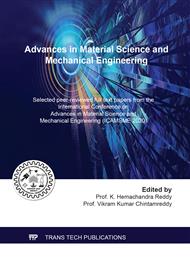[1]
Chung K and Kirit Shah Finite element simulation of sheet metal forming for planar anisotropic metals, International Journal of Plasticity Vol. 8.4: (1992), pp.453-476.
DOI: 10.1016/0749-6419(92)90059-l
Google Scholar
[2]
Reddy, A. S., Rajesham, S, Reddy, P R: Experimental study on strain variation and thickness distribution in deep drawing of axisymmetric components, International Journal of Current Engineering and Technology, Vol. 2.12, (2013), pp.2214-2219,.
DOI: 10.14741/ijcet/spl.2.2014.32
Google Scholar
[3]
Due Toan Nguyen, Duy Khoe Dinh, Hong Minh Thi Nguyen, Tien Long Banh and Young Suk Kim: Formability improvement and blank shape deformation for deep drawing of cylindrical cup with complex curve profile from SPCC sheets using FEM, j. Cent.South Univ, 21st edn:pp.27-34.
DOI: 10.1007/s11771-014-1911-x
Google Scholar
[4]
Wu, D., R. S. Chen, and E. H. Han: Excellent room-temperature ductility and formability of rolled Mg-Gd-Zn alloy sheets, Journal of Alloys and Compounds, pp.2856-2863.[5] Butuc M.C., A. Barata da Rocha, J.J. Gracio: A theoretical study on Forming Limit Diagrams Prediction, Journal of Materials Processing Technology, 142st edn, 2003, pp.714-724.
DOI: 10.1016/j.jallcom.2010.11.141
Google Scholar
[6]
Banabic D, Comsa D S, Jurco P, Wagner S, Van Houtte P: 2004. Prediction of forming limit curves from two anisotropic constitutive models, Proc. of the 7th Esaform Conference on Material Forming, pp.455-458.
DOI: 10.1007/978-3-319-44070-5_5
Google Scholar
[7]
Cazacu, Oana and Revil-Baudard, Benoit and Chandola, Nitin: Yield Criteria for Anisotropic Polycrystals, Plasticity-Damage Couplings, From Single Crystal to Polycrystalline Materials, 201-288, (2019).
DOI: 10.1007/978-3-319-92922-4_5
Google Scholar
[8]
Mevlut Turkoz, Osman Yigit, Murat Dilmec and H Selcuk Halkaci: Construction of Forming limit diagram fr AA 5754 and AA 2024 Aluminum alloys, Proceedings of the International Conference on aluminum alloys, September 5-9 (2010), Japan, Japan Institute of metals.
DOI: 10.4028/www.scientific.net/amr.264-265.12
Google Scholar
[9]
Sivam, SP Sundar Singh and Sekar, VG Uma and Saravanan, K and RajendraKumar, S and Karthikeyan, P and Moorthy, K Sathiya: Frequently used anisotropic yield criteria for sheet metal applications: A review, Indian Vol. 9(47), (2016), pp.1-6.
DOI: 10.17485/ijst/2015/v8i1/92107
Google Scholar
[10]
F. Djavanroodi, A. Derogar, Experimental and numerical evaluation of forming limit diagram for Ti6Al4V titanium and Al6061-T6 aluminum alloys sheets, Materials and Design Vol. 31 (2010), pp.4866-4875.
DOI: 10.1016/j.matdes.2010.05.030
Google Scholar
[11]
Reddy, A.S., Rajesham, S., Reddy, P.R., Ramulu, J. and Kumar, A., 2013. Experimental study on strain variation and thickness distribution in deep drawing of axisymmetric components. Int J Eng, 2(12), pp.2214-2218.
Google Scholar
[12]
Abdolvahed Kami, Bijan Mollaei Dariani, Ali Sadough Vanini, Dan Sorin Comsa,Dorel Banabic, Numerical determination of the forming limit curves of anisotropic sheet metals using GTN damage model , Journal of Materials Processing Technology Vol. 216 (2015), pp.472-483.
DOI: 10.1016/j.jmatprotec.2014.10.017
Google Scholar
[13]
Reddy, A. C. S., S. Rajesham, and P R Reddy: Experimental and simulation study on the warm deep drawing of AZ31 alloy, Advances in Production Engineering & Management Vol. 10.3 (2015), pp.153-161.
DOI: 10.14743/apem2015.3.199
Google Scholar


